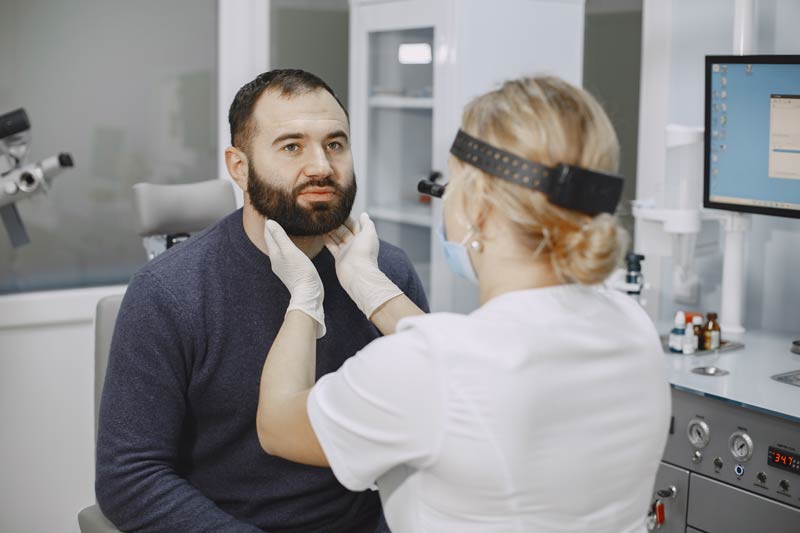Head & Neck Cancers & Masses
Types of Head & Neck cancers, and treatment options available at Austin ENT & Allergy

What are head and neck cancers?
Head and neck cancers develop in and around the throat, larynx, nose, sinuses, and mouth. Most of these cancers, known as squamous cell carcinomas, start in the cells lining the mucosal surfaces of the head and neck. If detected early, they are highly treatable.
These cancers are categorized based on where they form in the body:
Larynx: Also called the voicebox, this tube-shaped organ in the neck contains the vocal cords and plays a crucial role in speaking, swallowing, and breathing.
Oral cavity: Encompassing the lips, tongue, gums, and mouth.
Salivary glands: These glands produce saliva, keeping food moist and aiding in digestion.
Pharynx: This hollow tube begins behind the nose and extends to the esophagus and trachea.
Nasal cavity: Hollow spaces in the bones around the nose, through which air travels to the throat.
It’s important to note that while other cancers can develop in this area (such as brain tumors, esophageal cancer, thyroid cancer, etc.), they behave differently and are not classified as head and neck cancers.

What causes head and neck cancer?
The main factors that increase the risk of head and neck cancers include the use of tobacco (both smoking and chewing) and alcohol consumption, especially when these two are combined. Other risk factors involve exposure to industrial toxins like wood, dust, and paint fumes, inadequate oral hygiene, and infections caused by human papillomavirus and Epstein-Barr virus. Additionally, exposure to asbestos and radiation is recognized as contributing factors.
What are the symptoms of head and neck cancers?
Signs of head and neck cancers might mimic symptoms of other conditions and may not show obvious severity at first. Key indicators to watch for include a lasting lump or sore, persistent sore throat, difficulty swallowing, and hoarseness.
It’s important to stay vigilant for additional symptoms that may develop, such as bleeding from the mouth, swelling of the jaw, recurring congestion, headaches, earaches, facial numbness or paralysis, enlarged lymph nodes, and unexplained weight loss.

What are the treatment options available for head and neck cancers?
What are head and neck masses?
Several masses may form in the head or neck, referred to as growths, tumors, lumps, or bumps. While some of these masses may be cancerous, a significant number are not. It’s crucial to consult a doctor if any unusual bump or lump persists for more than two weeks. Early detection, if cancer is present, significantly increases the likelihood of successful treatment.

What causes head and neck masses?
There can be many causes for Head and Neck masses:
Enlarged lymph nodes
The most common reason for new neck masses is the enlargement of lymph nodes. These nodes, integral to the immune system, can enlarge as the body responds to an infection. Once the infection subsides, lymph swelling typically diminishes.
Benign lesions
Benign masses do not spread to surrounding tissue. However, they can pose a threat if they impact nerves or exert pressure in the head and neck, often requiring surgical removal. Examples include cysts, thyroid masses, vascular masses, salivary gland masses, and others.
Cancers
Malignant head and neck masses can spread to surrounding tissue or other parts of the body. Tumors in the head and neck can be primary or secondary.
Primary tumors originate within the head or neck, including the thyroid, throat, larynx, salivary gland, brain, or other locations. Typically, primary tumors in the head and neck spread to the lymph nodes in the neck.
Many head and neck cancers are linked to tobacco and alcohol use. Individuals exposed to radiation, whether through childhood medical treatments (common in past decades) or nuclear radiation sources, face a significant risk of thyroid cancer and should undergo screening.
Secondary cancers are tumors that have spread from primary tumors in other body parts to the head or neck. Most frequently, secondary neck tumors arise from the lung, breast, kidney, or skin cancers (such as squamous cell carcinoma or melanoma).

What are the symptoms of head and neck masses?
If you are experiencing any of the following symptoms, you should see a member of our ENT physician team:
- Lump in the neck lasting for more than two weeks, especially if it is not associated with a cold, flu, or other infection
- Voice change, including hoarseness that lasts more than two weeks
- Swollen tongue
- Growth in the mouth
- Difficulty swallowing
- Blood in the saliva or phlegm
- Lasting ear pain or ear pain while swallowing—may be a symptom of infection or a growth in the throat
- Unexplained weight loss
How are head and neck masses evaluated and treated?
An in-office physical examination of certain masses may enable a physician to identify their origin based on factors such as location, size, and consistency. However, in some cases, additional tests may be necessary. These tests include:
- Ultrasound
- Biopsy: Involves taking a tissue sample for microscopic examination to determine malignancy.
- CT Scan (Computed Tomography): Utilizes advanced x-ray technology and computer analysis to locate tumors, ascertain their type or size, detect surrounding swelling or bleeding, and guide treatment decisions. Injections of iodine dye contrast material are often used to enhance visibility during CT scans.
- MRI (Magnetic Resonance Imaging): Uses a magnetic field instead of x-ray radiation, providing clear images of smaller tumors and brainstem masses.
- PET (Positron Emission Tomography) and SPECT (Single Photon Emission Tomography): These tests are valuable post-head and neck cancer treatment to differentiate between cancer and scar tissue. They involve injecting a radioactive tracer.
Treatment plans are determined by the underlying cause of the mass. Benign neck cysts and masses are typically addressed through surgical excision. Head and neck cancers may be treated with a combination of radiation therapy, chemotherapy, and surgery, tailored to the specific nature of the condition.

Schedule an appointment
If you’re concerned about head and neck masses or cancers, the ENT physician team at Austin ENT & Allergy is prepared to help. Early detection and treatment can increase the chances of successful outcomes. Contact a member of the Austin ENT & Allergy team today to schedule an appointment at our convenient North Austin clinic.







